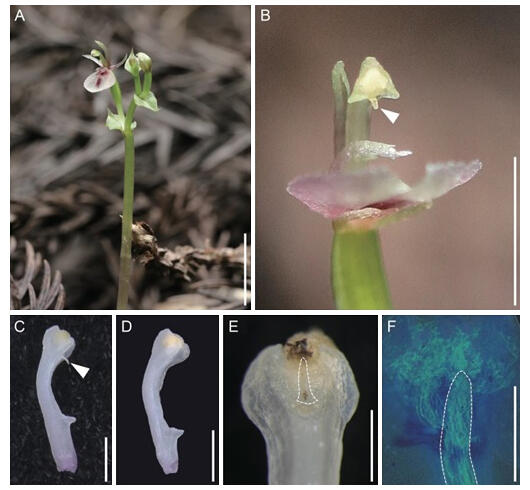Professor Kenji Suetsugu of the Graduate School of Science at Kobe University has announced that he elucidated the function of a structure after which the orchidaceous plant "Stigmatodactylus sikokianus" was so named. Examining the mode of pollination, he found that a finger-like appendage beneath the stigma collapses sometime after anthesis to facilitate self-pollination. S. sikokianus was discovered by the botanist Tomitaro Makino, and the Russian botanist Maximowicz gave high praise to Makino's illustrations and named the plant "Stigmatodactylus" on account of the finger-like (dactyliform) appendage beneath the stigma. However, its ecological significance has remained unknown for more than 130 years. The results were published in the international journal Plants, People, Planet on January 24.

(A) Whole plant. (B) Flower. (C) Column at the early flowering stage, showing dactyliform appendages beneath the stigma (arrow). (D) Column three days after anthesis, with the dactyliform appendages collapsed. (E) Upper part of the column three days after anthesis, with the dactyliform appendages bending toward the stigma (dashed line). (F) Pollen tube staining, showing a large number of pollen tubes extending from the stigma to the lower part of the column. The region enclosed by a dashed line represents the collapsed dactyliform appendages. Scale bars: 1 cm (A), 3 mm (B), 1 mm (C-D), and 500 µm (E-F).
Provided by Kobe University
Flowers of orchidaceous plants are very diverse, and many orchid species have specialized relationships with flower-visiting insects. Meanwhile, autonomous self-pollination is common among orchidaceous plants that grow in environments where flower-visiting insects are scarce. S. sikokianus, a member of the family Orchidaceae, was discovered by Makino in 1889 and is characterized by a <1 mm-long, finger-like appendage beneath the stigma. However, its function has remained unknown for a long time.
In response to this, Suetsugu aimed to elucidate the function of this finger-like appendage. Specifically, he conducted observations of the movement of the appendages during the flowering period, artificial pollination experiments, and observations of pollen tubes under a fluorescence microscope. The results showed that the appendage of S. sikokianus collapsed about 3 days after anthesis. Furthermore, after the appendage collapsed, pollen tubes extended through this appendage, and self-pollination was observed.
Pollen tube elongation did not occur until the appendage collapsed, indicating that this mechanism is a strategy to ensure successful pollination even when cross-pollination by flower-visiting insects is unsuccessful. The self-pollination strategy involving the collapse of the stigma appendage at a later flowering stage is considered an adaptation to ensure successful seed production even in dark forest floor environments where virtually no flower-visiting insects are available.
Suetsugu said, "I am very happy to have solved the homework left by Makino 130 years ago. I also learned that examinations of taxonomically important structures can deepen our understanding of ecology. Research fields are segmentalized these days, but I have noticed that old-fashioned natural history research combining taxonomy, evolution, and ecology is still valid and important."
Journal Information
Publication: Plants, People, Planet
Title: Dactyliform appendage contributes to delayed selfing in the diminutive orchid Stigmatodactylus sikokianus
DOI: 10.1002/ppp3.10624
This article has been translated by JST with permission from The Science News Ltd. (https://sci-news.co.jp/). Unauthorized reproduction of the article and photographs is prohibited.




